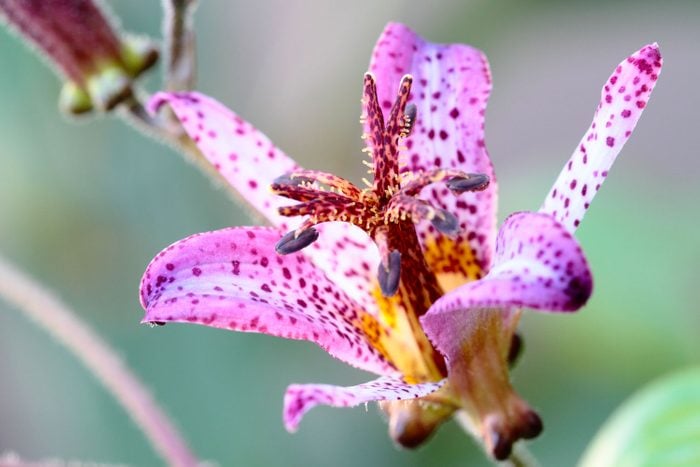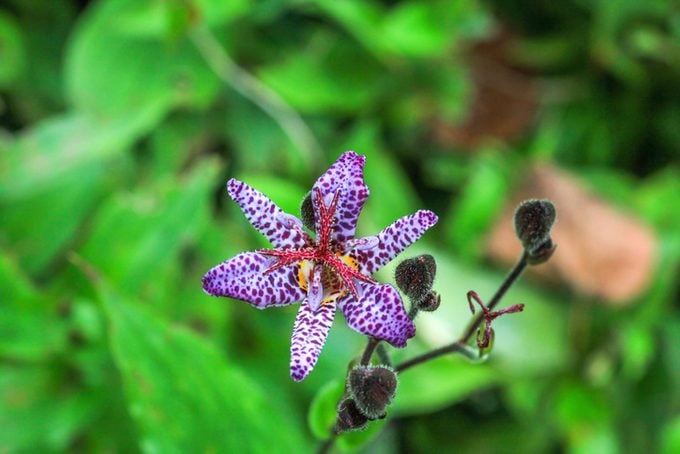Toad Lily: How To Grow This Gorgeous Fall Flower
Updated: Apr. 10, 2024

What grows in the shade, blooms in the fall, and comes in varieties with variegated foliage and spotted flowers? Toad lilies!
Our editors and experts handpick every product we feature. We may earn a commission from your purchases.
I remember the first time I saw a toad lily in bloom. The friend who showed it to me described it as “just an old toad lily.” What? I thought it was one of the most unusual and exotic flowers I’d seen in quite some time. Now I’m happy to have several “old toad lilies” in my garden.
On This Page
What Is a Toad Lily?
Toad lilies can be the surprise of your fall garden. These shade-loving perennial flowers are native to Japan and Asia. Other common names include Japanese toad lily and hairy toad lily.
All toad lilies are in the plant genus Tricyrtis and belong to the lily family of plants. Most, but not all, feature spotted flowers that resemble small orchids.
Types of Toad Lilies

There are several varieties available today, some with green leaves, some with variegated leaves. A few to look for include:
- Tricyrtis formosana: Hardy in U.S. Department of Agriculture Plant Hardiness Zones 4 through 9, it has white flowers with purplish-red spots.
- Tricyrtis hirta: Hardy in Zones 4 through 8, and it also has white flowers, covered in purplish spots.
- Tricyrtis formosana ”Samurai’: Features purplish-blue flowers with red spots, and leaves tipped with yellow-gold. I have this one in my garden. It’s hardy in Zones 5 through 9.
- Tricrytis ‘Imperial Banner’: A rarer variety with heavily variegated leaves and purple spotted flowers. Over time, it can revert to all green leaves. Hardy in Zones 6 through 8, it’s survived in my Zone 6a garden for several years.
How To Plant Toad Lilies
Most toad lilies are sold as potted plants or bare roots. If you find them at a local garden center, they will most often be growing plants. If you order them online or from a mail-order nursery, you’ll likely get a bare root to plant, although some do ship growing plants.
When planting, choose a location with well-drained soil that stays moist but not soggy, in part-shade to shade. Toad lilies can handle more sun in colder zones; in warmer zones, they do best in more shade. Plant as you would other perennials, and add a one- to two-inch layer of mulch to keep them from drying out.
How To Care for Toad Lilies
Watering
Toad lilies like evenly moist soil; don’t let newly planted ones dry out. Once established, they will survive dry periods in the summer.
Fertilizing
If you use compost-enriched soil, toad lilies don’t usually need additional fertilizer.
Pests and diseases
I’ve never had any problems with pests or diseases on my toad lilies. According to the Wisconsin Horticulture, Division of Extension, slugs can occasionally be a problem, and rabbits may nibble on leaves. But deer will leave them alone.
If slugs or rabbits are a problem, several non-toxic treatments will keep them away from your plants.
To avoid infection with anthracnose leaf spot, a fungal disease, don’t overcrowd your plants and avoid watering with overhead sprinklers. A trickle of water applied around the base of the plant works best.
Deadheading
I don’t feel the need to deadhead my toad lilies, which begin blooming in late summer and continue all the way through fall. Once the foliage dies back, leave it standing, then cut it off in spring before new growth emerges. That’s what I usually do. Or cut it off in early winter.
Dividing
Toad lilies are clump-forming perennials. Where they’re happily growing, they may be large enough to divide, just like any other perennial.
Here’s how: Dig up the entire plant, tease it apart into several sections, then replant where desired. Don’t forget the time-honored tradition of giving extra plants to other gardeners.
Why Is My Variegated Toad Lily Turning All Green?
Some toad lilies with heavily variegated leaves may also have some stems with all green leaves. These are often stronger and will grow faster, taking over and crowding out the stems with variegated leaves.
If you notice all green leaves on some stems (like ‘Imperial Banner’), remove those stems. If there are more stems with all green leaves with variegated leaves, dig up the entire plant, separate it into variegated and not variegated sections and replant.
